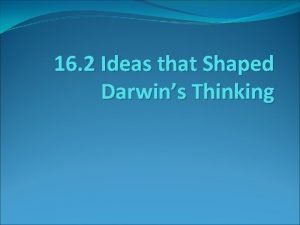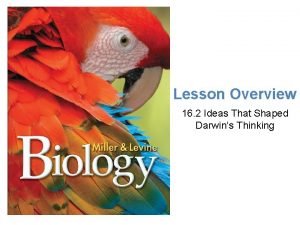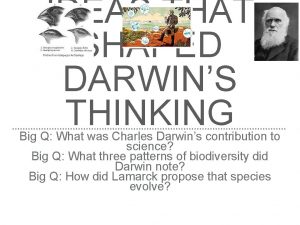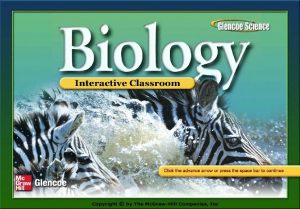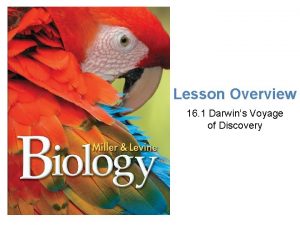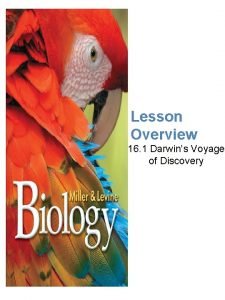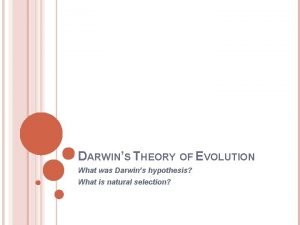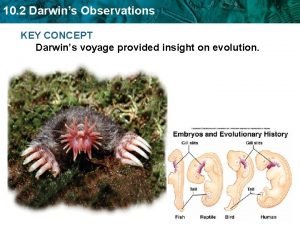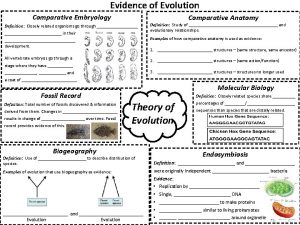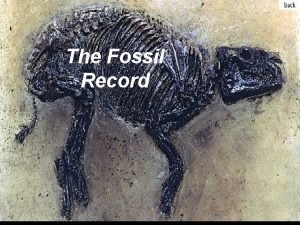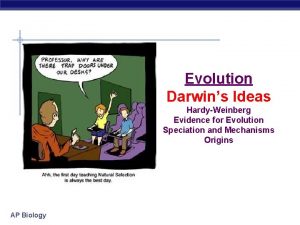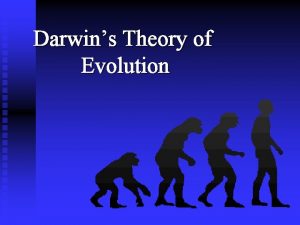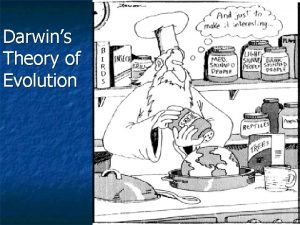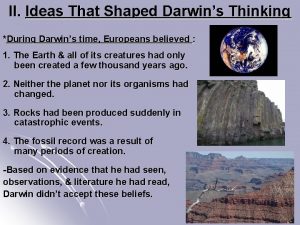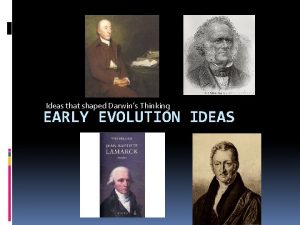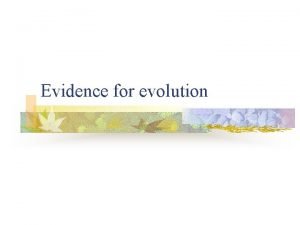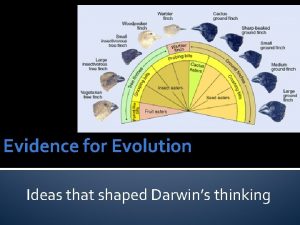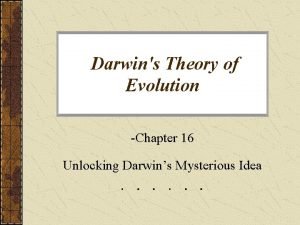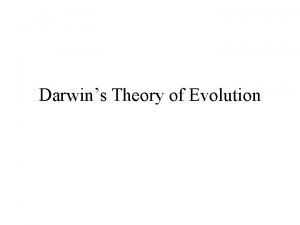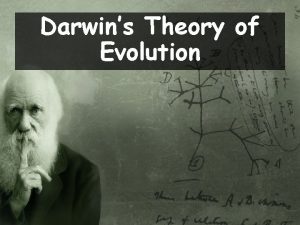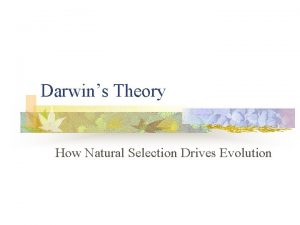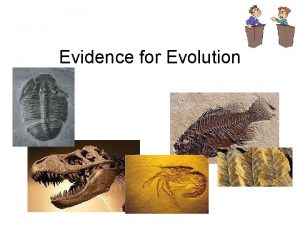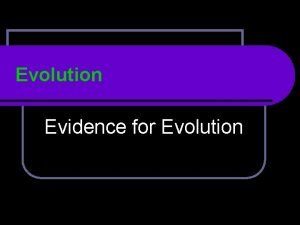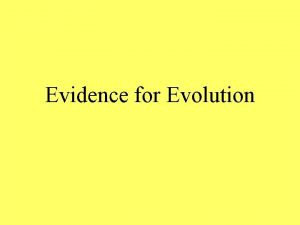EVOLUTION QUESTIONS Darwins ideas and Evidence of Evolution






















- Slides: 22

EVOLUTION QUESTIONS Darwin’s ideas and Evidence of Evolution

WHAT IS EVOLUTION? changes in the gene pool of a population over time

WHAT CAUSES A POPULATION TO EVOLVE? ratios of alleles for different genes in the gene pool change

5 FACTORS THAT INFLUENCED DARWIN’S EVOLUTIONARY THEORY • __c___Lyell and Hutton a. inborn urges allow organisms to • __a___Lamarck b. nature provides variations in species that humans select and use for breeding • __e___Matlhus • __b___artificial selection c. geologists that believed earth was old and has always changed over time d. each island had species that seemed • __d___Galapagos trip e. economist that argued that limited change themselves by acquiring features that would help them live more successfully in their environments related but differed in structure and eating habits resources could not match the rate of population growth

WHAT IS THE STRUGGLE FOR EXISTENCE? because of limited food supplies, young born to a species compete for survival

WHAT ORGANISMS WOULD BE SUCCESSFUL ACCORDING TO DARWIN? Those that have favorable natural variations which are passed on to offspring when they reproduce

WHAT IS NATURAL SELECTION? process in nature that over time results in the survival of the fittest

HOW DO EACH OF THESE AFFECT NATURAL SELECTION? Variation- there must be variations within a population Competition- overproduction of offspring leads to competition for resources Adaptations-beneficial adaptations allow survival and reproduction Selection-changes in allele frequencies drive evolution

WHAT ARE THE 3 REQUIREMENTS FOR NATURAL SELECTION? 1. more individuals born than can survive 2. natural heritable variation 3. variable fitness

DEFINE ADAPTATIONS. WHAT MAKES AN ADAPTATION DESIRABLE? physical & behavioral traits that enable organisms to survive and reproduce in a given environment

WHAT IS FITNESS? HOW IS IT MEASURED? the ability of an individual to survive and reproduce; measured by ability to successfully pass on genes to offspring

WHAT FACTOR ULTIMATELY DRIVES EVOLUTION? the environment in which an organism lives

HOW DID DARWIN COUNTERACT THE ATTACK ON HIS IDEAS ABOUT NATURAL SELECTION? 1. assembled evidence that living things have changed over time 2. proposed a hypothesis explaining how and why evolution occurs

WHAT ARE THE 5 PIECES OF EVIDENCE THAT DARWIN USED TO SUPPORT HIS IDEAS? __b_1. biogeography a. same groups of embryonic cells _c__2. fossils develop in the same order and pattern to produce homologous tissues and organs b. where organisms live now versus where they and their ancestors once lived _d__3. homologous structures c. similarities in remains of ancient and modern organisms _a__4. embryology d. similar structures having a different function _e__5. genetics and molecular biology e. the universal genetic code

WHAT IS THE PRINCIPLE OF COMMON DESCENT? all species both living and extinct descended from ancient common ancestors over time

WHAT IS DESCENT WITH MODIFICATION? WHAT EVIDENCE SUPPORTED THIS IDEA? idea that living species descended, with modification, from common ancestors; fossils

WHAT EVIDENCE DO HOMOLOGOUS STRUCTURES PROVIDE? related species with similar structures evolved from a common ancestor with a basic version of that structure

ANALOGOUS STRUCTURES? body parts that share a common function, but not structure Structure, not function, is key to evolution

VESTIGIAL STRUCTURES? structures inherited from ancestors that have lost much or all of their original function due to different selection pressures

WHAT IS EMBRYOLOGY? study of early developmental stages of vertebrates, which all look very similar; provides evidence of common ancestry

HOW ARE HERITABLE VARIATIONS IN SPECIES PRODUCED? mutations and reshuffling of genes during sexual reproduction produce heritable variations key to natural selection operating

HOW DOES DNA HELP PROVIDE EVIDENCE OF EVOLUTION AND COMMON ANCESTRY? similarities in the genetic code of organisms provide evidence that all organisms evolved from common ancestors minor genome changes often produce major changes in structures
 Section 15-2 ideas that shaped darwins thinking
Section 15-2 ideas that shaped darwins thinking Section 15-2 ideas that shaped darwins thinking
Section 15-2 ideas that shaped darwins thinking Ideas that shaped darwin's thinking
Ideas that shaped darwin's thinking Section 15-2 ideas that shaped answer key
Section 15-2 ideas that shaped answer key Chapter 17 darwins theory of evolution
Chapter 17 darwins theory of evolution Chapter 15 section 1 darwins theory of natural selection
Chapter 15 section 1 darwins theory of natural selection Section 2 darwins observations study guide a
Section 2 darwins observations study guide a Species vary locally
Species vary locally Lesson 1 a voyage of discovery
Lesson 1 a voyage of discovery Darwin's hypothesis
Darwin's hypothesis Darwins observations
Darwins observations Individual evidence can have probative value
Individual evidence can have probative value Anatomy and embryology evidence of evolution
Anatomy and embryology evidence of evolution Evidence of evolution of remnants and impressions *
Evidence of evolution of remnants and impressions * Primary evidence vs secondary evidence
Primary evidence vs secondary evidence Primary evidence vs secondary evidence
Primary evidence vs secondary evidence Secondary sources
Secondary sources Primary evidence vs secondary evidence
Primary evidence vs secondary evidence Jobs vancouver
Jobs vancouver How can class evidence have probative value
How can class evidence have probative value Class evidence vs individual evidence
Class evidence vs individual evidence Individual vs class evidence
Individual vs class evidence Ecological fallacy meaning
Ecological fallacy meaning

